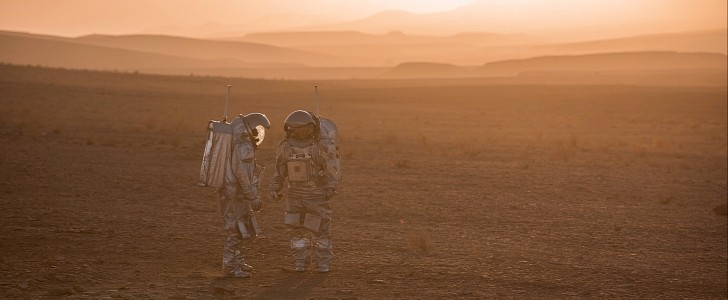A six-member field crew dressed in spacesuits is venturing on a three-week mission inside a huge crater in Israeli's Negev desert to simulate conditions on Mars. The team will research astronauts' mental and physical health during the mission and test rovers and drones.
Called Amadee-20, the mission is carried out by the Austrian Space Forum (Österreichisches Weltraum Forum, OeWF), a research organization involved in cutting-edge interdisciplinary research.
So far, the OeWF has organized 12 international expeditions in Mars-like locations such as Morocco's Northern Sahara, Utah, southern Spain, and Oman and high altitude glacier missions.
The Amadee-20 is the organization's latest mission in which it will cooperate with the Israel Space Agency to conduct an integrated Mars analog field mission in the Ramon Crater, Negev desert. The 25-miles (40-kilometer) long and 1,640-foot (500-meter) deep site has a similar topography to that of the Red Planet and therefore makes it an ideal setting for simulating the Martian environment.
The expedition will be led by a team of six highly trained analog astronauts who will live and work in a specially designed habitat. When they perform activities outside the habitat, they will wear a spacesuit prototype developed by the OeWF.
The team consisting of one woman and five men from Austria, Germany, Israel, Spain, Portugal, and the Netherlands will conduct more than 25 experiments that will help astronauts prepare for future Mars exploration missions. Two of the experiments are part of a European Space Agency (ESA) project in which the OeWF is involved. In one of them, the crew will focus on moon dust.
During lunar expeditions, the moon dust is the leading cause of a multitude of health and technical difficulties. To help astronauts overcome these issues, the team will test different methods that can keep technical devices free of it. In addition, an ESA 3D printer will be examined to see if space-grade plastics can be created to facilitate scientific investigations in remote, harsh environments.
Other experiments include testing out drones, rovers and analyzing the mental and physical health of the astronauts while in isolation.
So far, the OeWF has organized 12 international expeditions in Mars-like locations such as Morocco's Northern Sahara, Utah, southern Spain, and Oman and high altitude glacier missions.
The Amadee-20 is the organization's latest mission in which it will cooperate with the Israel Space Agency to conduct an integrated Mars analog field mission in the Ramon Crater, Negev desert. The 25-miles (40-kilometer) long and 1,640-foot (500-meter) deep site has a similar topography to that of the Red Planet and therefore makes it an ideal setting for simulating the Martian environment.
The expedition will be led by a team of six highly trained analog astronauts who will live and work in a specially designed habitat. When they perform activities outside the habitat, they will wear a spacesuit prototype developed by the OeWF.
The team consisting of one woman and five men from Austria, Germany, Israel, Spain, Portugal, and the Netherlands will conduct more than 25 experiments that will help astronauts prepare for future Mars exploration missions. Two of the experiments are part of a European Space Agency (ESA) project in which the OeWF is involved. In one of them, the crew will focus on moon dust.
During lunar expeditions, the moon dust is the leading cause of a multitude of health and technical difficulties. To help astronauts overcome these issues, the team will test different methods that can keep technical devices free of it. In addition, an ESA 3D printer will be examined to see if space-grade plastics can be created to facilitate scientific investigations in remote, harsh environments.
Other experiments include testing out drones, rovers and analyzing the mental and physical health of the astronauts while in isolation.








